| Latest | Greatest | Lobby | Journals | Search | Options | Help | Login |
|
|
|
This topic is archived. |
| Home » Discuss » Topic Forums » Sports |
|
| Jack Rabbit
|
Fri Oct-31-08 10:59 PM Original message |
| The Jack Rabbit Chess Report (October 31): VISHY!! |
|
Edited on Fri Oct-31-08 11:02 PM by Jack Rabbit
Anand Defends World Title
  Reigning champ Vishy Anand won his title match against former champion Vladimir Kramnik Wednesday by drawing the eleventh game in Bonn. Anand won the scheduled 12 game match 6½-4½. Anand had three wins to Kramnink's one with seven drawn games. Anand took charge of the match by winning games five and six last week to take a three-point advantage over Kramnik. Kramnik won the tenth game, but by then he had to win all of the remaining games to force a tiebreak. Anand won the title in a tournament in Mexico City a year ago among eight of the strongest grandmasters in the world. Kramnik, who was the reigning world champion when the match began, finished second in the event as the title passed to Anand. Kramnik held the world title from October 2000, when he defeated then-champion Garry Kasparov in a 14-game match in London. However, his claim on the title was tainted with the dispute between Kasparov and FIDE, the world chess governing body, which ceased to recognize Kasparov as the chapion in 1993, although he was clearly the strongest player in the world even after his loss to Kramnik. Kramnik defended his title twice, once against Peter Leko in Switzerland in 2004 and then in a reunification match against Topalov, who had come to be recognized as the world champion by FIDE, in 2006. Anand's next defense of his title will be sometime in 2009 against the winner of a match between Veselin Topalov of Bulgaria, the former FIDE champion, and Russo-American grandmaster Gata Kamsky. That match is scheduled to take place in Lvov, Ukraine, in November and December. 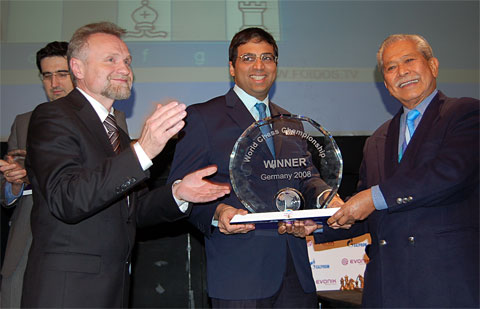 World Champion Vishy Anand presented with the Winner's Trophy in Bonn Wednesday Svidler Takes Russian Championship in Rapid Playoff  Peter Svidler of St, Petersburg won his fifth Russian national championship Tuesday by surviving a three-way, six-round rapid playoff with Dmitry Jakovenko and former champion Evgeny Alekseev. The trio of grandmasters were tied for first place after the regularly scheduled 11-round "Superfinal" held earlier this month in Moscow with 7 points each. Svidler had to win the sixth and final game against Jakovenko to take the title. Jakovenko entered the round with a half-point lead over Svidler and only needed to avoid loss to take the title for himself. Svidler, 32, previously won the Russian national championship in 1994, 1995, 1997 and 2003. He follows cricket, is a fan of Bob Dylan and speaks excellent English. Cap d'Agde Rapid Fianl pits Ivanchuk against Nakamura 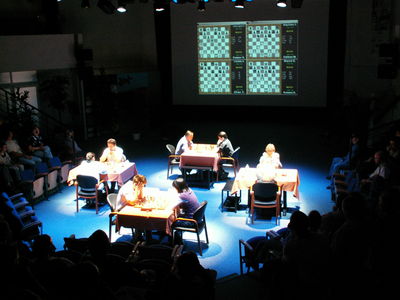 The final match of the annual grandmasters' rapid tournament in the southern French resort of Cap d'Agde will take place tomorrow between Ukrainian grandmaster Vassily Ivanchuk and the young American GM Hikaru Nakamura. In semi-final matches played today, Ivanchuk defeated Magnus Carlsen while Nakamura advanced at the expense of former world champion Anatoly Karpov. Calendar Pan-American Championship, Boca Raton, Florida 1-7 November. Chess Olympiad, Dresden 12-25 November. Topalov-Kamsky World Championship Semifinal Match, Lvov 26 November-15 December. Eight Rounds. Winner will challenge Anand or Kramnik in 2009. FIDE Grand Prix, Doha 13-29 December. Hasting Chess Tournament 28 December 2008-5 January 2009. Rilton Cup, Stockholm 28 December 2008-5 January 2009. Corus Chess Tournament, Wijk aan Zee 16 January-1 February 2009. |
| Printer Friendly | Permalink | | Top |
| Jack Rabbit
|
Fri Oct-31-08 11:03 PM Response to Original message |
| 1. Match for the World Title, Bonn |
|
Edited on Fri Oct-31-08 11:04 PM by Jack Rabbit
Your humble hare acknowledges the assistance of Fritz 6.0 on analysis. Diagrams on the Jack Rabbit Chess Report are made with Chess Mérida, a true type font that can be downlaoded free here. !""""""""# $tMvWlVmT% $OoOoOoOo% $ + + + +% $+ + + + % $ + + + +% $+ + + + % $pPpPpPpP% $RnBqKbNr% /(((((((() WHITE White to move (This position is a theoretical draw) |
| Printer Friendly | Permalink | | Top |
| Jack Rabbit
|
Fri Oct-31-08 11:05 PM Response to Reply #1 |
| 2. Kramnik 1-0 Anand, Game 10 |
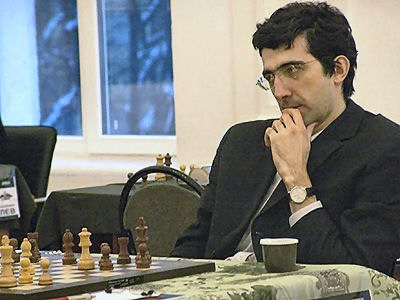 Vladimir Kramnik Vladimir Kramnik - Vishy Anand Match for the World Title, Round 10 Bonn, 27 October 2008 East India Game: Nimzo-Indian Defense (Catalan Opening) 1.d4 Nf6 2.c4 e6 3.Nc3 Bb4 4.Nf3 c5
5.g3
5...cxd4 6.Nxd4 0-0
7.Bg2 d5 8.cxd5
8...Nxd5 9.Qb3
9...Qa5
10.Bd2 Nc6 11.Nxc6 bxc6 12.0-0 Bxc3 13.bxc3
13...Ba6 14.Rfd1 Qc5 15.e4 Bc4
16.Qa4 Nb6 17.Qb4 Qh5 18.Re1!?
18...c5
19.Qa5 Rfc8 20.Be3
20...Be2 21.Bf4
21...e5 22.Be3!?
!""""""""# $t+t+ +l+% $O + +oOo% $ M + + +% $Q O O +w% $ + +p+ +% $+ P B P % $p+ +vPbP% $R + R K % /(((((((() WHITE: Vladimir Kramnik Position after 22.Bf4e3 22...Bg4?
23.Qa6!
23...f6
24.a4 Qf7
!""""""""# $t+t+ +l+% $O + +wOo% $qM + O +% $+ O O + % $p+ +p+v+% $+ P B P % $ + + PbP% $R + R K % /(((((((() WHITE: Vladimir Kramnik Position after 24...Qh5f7 25.Bf1!
25...Be6
26.Rab1 c4
27.a5!
27...Na4 28.Rb7 Qe8 29.Qd6 1-0
|
| Printer Friendly | Permalink | | Top |
| Jack Rabbit
|
Fri Oct-31-08 11:06 PM Response to Reply #1 |
| 3. Anand ½-½ Kramnik, Game 11 |
|
The final game of the match.
 Vladimir Kramnik and Vishy Anand with their trophies after the game Vishy Anand - Vladimir Kramnik Match for the World Title, Round 11 Bonn, 29 October 2008 Open Sicilian Game: Najdorf-Scheveningen Defense (Rauzer Opening) 1.e4 c5 2.Nf3 d6 3.d4 cxd4 4.Nxd4 Nf6 5.Nc3 a6 6.Bg5 e6 7.f4 Qc7 8.Bxf6
8...gxf6 9.f5
9...Qc5
10.Qd3 Nc6 11.Nb3 Qe5 12.0-0-0!?
12...exf5
13.Qe3 Bg7!?
!""""""""# $t+v+l+ T% $+o+ +pVp% $o+mO O +% $+ + Wo+ % $ + +p+ +% $+nN Q + % $pPp+ +pP% $+ Kr+b+r% /(((((((() WHITE: Vishy Anand Position after 13...Bf8g7 14.Rd5
14...Qe7 15.Qg3
15...Rg8
16.Qf4 fxe4
17.Nxe4 f5
18.Nxd6+ Kf8 19.Nxc8
19...Rxc8 20.Kb1 Qe1+ 21.Nc1 Ne7
22.Qd2 Qxd2 23.Rxd2 Bh6 24.Rf2
24...Be3 ½-½
!""""""""# $ +t+ Lt+% $+o+ Mo+o% $O+ + + +% $+ + +o+ % $ + + + +% $+ + V + % $pPp+ RpP% $+kN +b+r% /(((((((() WHITE: Vishy Anand Final Position after 24...Bh6e3 |
| Printer Friendly | Permalink | | Top |
| Jack Rabbit
|
Fri Oct-31-08 11:07 PM Response to Original message |
| 4. Other Games |
| Printer Friendly | Permalink | | Top |
| Jack Rabbit
|
Fri Oct-31-08 11:08 PM Response to Reply #4 |
| 5. Zelcic - Malakhov, European Club Cup, General Competition, Round 5, Kallithea |
|
Vladimir Malakhov scored a perfect 7/7 to lead Sverdlovsk to the European Club Cup.
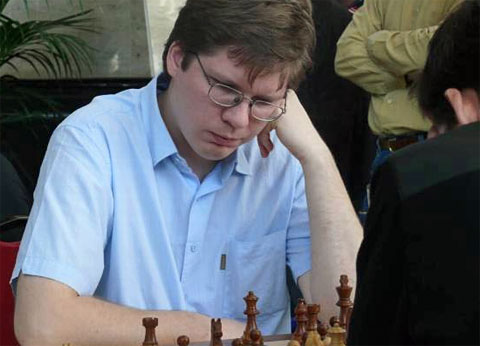 Vladimir Malakhov Robert Zelcic (Zagreb) - Vladimir Malakhov (Sverdlovsk) European Team Championship (General Competition), Round 5 Kallithea, 21 October 2008 Open Sicilian Game: Scheveningen Four Knights' Opening (Rauzer Variation) 1.e4 c5 2.Nf3 Nc6 3.d4 cxd4 4.Nxd4 Nf6 5.Nc3 d6 6.Bg5 e6 7.Qd2 Be7
8.0-0-0 a6 9.f4 Nxd4
10.Qxd4 b5 11.Bxf6
11...gxf6 12.e5
12...d5 13.Bd3?!
13...f5 14.g4 b4!?
15.Na4
15...Qa5 16.b3 fxg4 17.f5
17...Bd7?!
18.Qxg4 0-0-0?!
19.fxe6?!
!""""""""# $ +lT + T% $+ +vVo+o% $o+ +p+ +% $W +oP + % $nO + +q+% $+p+b+ + % $p+p+ + P% $+ Kr+ +r% /(((((((() WHITE: Robert Zelcic Position after 19.fe6:p 19...fxe6 20.Kb1
20...Rdg8 21.Qh3
21...Rg5 22.Qe3
22...Kb8 23.h4 Rg4
24.Rhf1 Bxa4!
25.bxa4 Rxh4 26.Qg3
26...Rc8 27.Rf6?
!""""""""# $ Lt+ + +% $+ + V +o% $o+ +oR +% $W +oP + % $pO + + T% $+ +b+ Q % $p+p+ + +% $+k+r+ + % /(((((((() WHITE: Robert Zelcic Position after 27.Rf1f6 27...b3!!
28.Qxh4 Qc3 29.Qf2 Bc5 30.axb3
30...Bxf2 31.Rxf2 Qxe5 32.Bxa6 Rc7
33.Re2
33...Qf6 34.Bb5 Re7 35.Rg2
35...Qc3 36.Re2
36...Qf6
37.Rg2 Ka7 38.Rg3
38...h5 39.b4 Qf4 40.Rb3
40...Rb7 41.Ka2
41...h4 42.Rdb1 Rg7 43.a5 Qd2 44.Bd3
44...Rg3 45.Ka3 h3 46.Rf1 h2 47.Rf7+ Kb8 0-1
|
| Printer Friendly | Permalink | | Top |
| Jack Rabbit
|
Fri Oct-31-08 11:10 PM Response to Reply #4 |
| 6. Dzagnidze - Gaponenko, European Club Cup, Women's Competition, Round 7, Kallithea |
|
Nana Dzagnidze scored 6 out of 7 to lead her Monte Carlo team to the Women's European Club Cup. This game was from the final round.
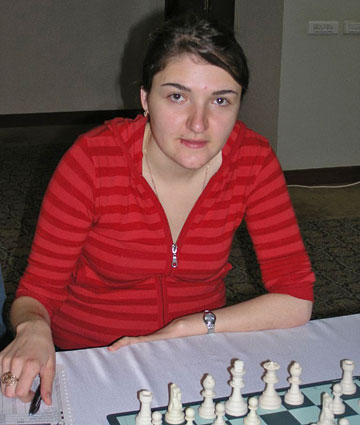 Nana Dzagnidze Nana Dzagnidze (Monte Carlo) - Inna Gaponenko (Podgorica) European Team Championship (Women's Competition), Round 7 Kallithea, 23 October 2008 Semi-Slav Queen's Gambit: Anti-Meran Gambit (Moscow Defense) 1.d4 Nf6 2.c4 c6 3.Nc3 d5 4.Nf3 e6 5.Bg5 h6 6.Bh4 dxc4 7.e4 g5 8.Bg3 b5 9.Be2 Bb7 10.0-0
10...Nbd7 11.d5
11...cxd5 12.exd5 Nxd5 13.Nxb5 Qb6
14.Bxc4 Nf4!?
15.Re1
15...Rc8 16.Bf1
16...Be7 17.a4
17...a5 18.Rc1 Rxc1
19.Qxc1 Bc5?!
20.Nd2 Bb4? !""""""""# $ + +l+ T% $+v+m+o+ % $ W +o+ O% $On+ + O % $pV + M +% $+ + + b % $ P N PpP% $+ Q RbK % /(((((((() WHITE: Nana Dzagnidze Position after 20...Bc5b4
21.Bxf4!
21...gxf4 22.Nc4 Qc6
23.Rd1 Rg8
24.Ncd6+ Bxd6
25.Nxd6+ Ke7 26.Nxb7
26...Qxb7 27.Qxf4 Nb6
!""""""""# $ + + +t+% $+w+ Lo+ % $ M +o+ O% $O + + + % $p+ + Q +% $+ + + + % $ P + PpP% $+ +r+bK % /(((((((() WHITE: Nana Dzagnidze Position after 27,,,Nd7b6 28.Qh4+!
28...f6 29.Qxh6 Rf8 30.Qg7+ Rf7 31.Qg3 Nd5
32.Bc4 Qxb2 33.Bxd5 exd5 34.Qc7+
34...Kf8 35.Qc5+ Kg7 36.Qxa5 Rd7 37.Qb5 1-0
|
| Printer Friendly | Permalink | | Top |
| Jack Rabbit
|
Fri Oct-31-08 11:11 PM Response to Reply #4 |
| 7. Svidler - Jakovenko, Russian National Championship Playoff, Round 6, Moscow |
|
Edited on Fri Oct-31-08 11:12 PM by Jack Rabbit
After 5 rounds in the three-way playoff for the Russian national championship in Moscow, Jakovenko led with 3 points to Svidler's 2½. Svidler, a skillful drawing master, had to play for a win.
 Peter Svidler Peter Svidler - Dmitry Jakovenko Russian National Championship Playoff (Rapid), Round 6 Moscow, 28 October 2008 Spanish Grand Royal Game: Clam Opening 1.e4 e5 2.Nf3 Nc6 3.Bb5 a6 4.Ba4 Nf6 5.0-0 Be7 6.d3!?
6...b5 7.Bb3 d6
8.a4 Bd7
9.c3
9...0-0 10.Nbd2 Na5 11.Ba2!?
11...c5
12.Re1 h6
13.Nh4!?
13...Kh7!
14.Nf5 Bxf5 15.exf5 Nc6
16.g4!?
16...Kg8
17.h4
17...Nh7
18.Bd5 Rc8 19.axb5!
19...axb5 20.Qf3 Nb8
21.g5!?
21...hxg5 22.Ne4 Nd7?
!""""""""# $ MtW Tl+% $+ + VoOm% $ + O + +% $+oObOpO % $ + +n+ P% $+ Pp+q+ % $ P + P +% $R B R K % /(((((((() WHITE: Peter Svidler Position after 22...Nb8d7 23.hxg5!
23...Nxg5 24.Bxg5 Bxg5 25.Ra6
25...Qe7?
26.Ra7!
26...Rfd8
27.Qh5 Bh6 28.Kh1
28...Kh8 29.Rg1!
29...Nf6 !""""""""# $ +tT + L% $R + WoO % $ + O M V% $+oObOp+q% $ + +n+ +% $+ Pp+ + % $ P + P +% $+ + + Rk% /(((((((() WHITE: Peter Svidler Position after 29...Nd7f6 30.Nxf6!!
30...Qxa7
31.Ng4 Kh7
32.Nxh6 gxh6
33.f6 Rg8
34.Be4+ Rg6 35.Rxg6 1-0
|
| Printer Friendly | Permalink | | Top |
| Jack Rabbit
|
Fri Oct-31-08 11:13 PM Response to Reply #4 |
| 8. Terekhov - Pentala, Bundesliga, Round 3, Munich |
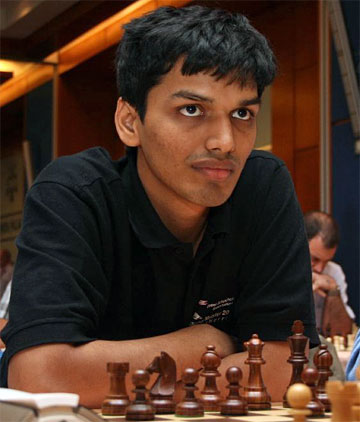 Pentala Harikrishna Andrey Terekhov (Munich) - Pentala Harikrishna (Baden-Baden) Bundesliga 0809, Round 3 Munich, 25 October 2008 West India Game: Tal-Indian Defense (Catalan Opening) (Modern Benoni) 1.d4 Nf6 2.c4 e6 3.Nf3 c5 4.d5 exd5 5.cxd5 g6 6.Nc3 d6 7.g3
7...Bg7 8.Bg2 0-0 9.0-0 a6
10.a4 Nbd7 11.Nd2
11...Re8 12.h3 Qc7
13.Nc4 Nb6 14.Na3 Bd7!?
15.e4
15...Rab8 16.Re1
16...Nc8 17.Qd3!
17...Re7 18.Bf1 Be8 19.Bd2
19...Nd7!?
20.f4 c4 21.Qxc4?!
21...Qb6+!
22.Kh1
22...Qxb2 23.Ra2 Qb6 24.Rb1
24...Qd8 25.Rc2
25...Nc5 26.e5?
!""""""""# $ TnWv+l+% $+o+ ToVo% $o+ O +o+% $+ MpP + % $o+q+ P +% $N N + Pp% $ +rB + +% $+r+ +b+k% /(((((((() WHITE: Andrey Terekhov Position after 26.e4e5 26...Rc7!
27.exd6
27...Nxd6 28.Qb4
28...Nf5 29.Ne2
!""""""""# $ T Wv+l+% $+oT +oVo% $o+ + +o+% $+ Mp+m+ % $pQ + P +% $N + + Pp% $ +rBn+ +% $+r+ +b+k% /(((((((() WHITE: Andrey Terekhov Position after 29.Nc3e2 29...Qxd5+!
30.Bg2 Qe6 31.Rxc5 Bf8!
32.Re5 Bxb4
33.Rxe6 Bxd2 34.Rxa6 Re7!
35.g4
35...Rxe2 36.gxf5 bxa6 37.Rxb8
!""""""""# $ R +v+l+% $+ + +o+o% $o+ + +o+% $+ + +p+ % $p+ + P +% $N + + +p% $ + Vt+b+% $+ + + +k% /(((((((() WHITE: Andrey Terekhov Position after 37.Rb1b8:R 37...Re1+!
38.Bf1
38...Rxf1+ 39.Kg2 Re1 0-1
|
| Printer Friendly | Permalink | | Top |
| DU
AdBot (1000+ posts) |
Tue Apr 30th 2024, 08:38 AM Response to Original message |
| Advertisements [?] |
| Top |
| Home » Discuss » Topic Forums » Sports |
|
Powered by DCForum+ Version 1.1 Copyright 1997-2002 DCScripts.com
Software has been extensively modified by the DU administrators
Important Notices: By participating on this discussion board, visitors agree to abide by the rules outlined on our Rules page. Messages posted on the Democratic Underground Discussion Forums are the opinions of the individuals who post them, and do not necessarily represent the opinions of Democratic Underground, LLC.
Home | Discussion Forums | Journals | Store | Donate
About DU | Contact Us | Privacy Policy
Got a message for Democratic Underground? Click here to send us a message.
© 2001 - 2011 Democratic Underground, LLC